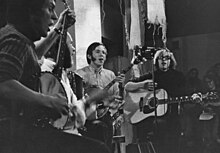| This article relies largely or entirely on a single source. Relevant discussion may be found on the talk page. Please help improve this article by introducing citations to additional sources. Find sources: "Pihasoittajat" – news · newspapers · books · scholar · JSTOR (April 2024) |

Pihasoittajat (1969 to 1975) was a Finnish folk music band with modern popular music influences.
History
Pihasoittajat was founded in 1969 in Finland as an Irish folk music band. The group's founding members included Henrik Bergendahl, Kim Kuusi, Hannu Karlsson, Harry Lindahl, and Kyösti Pärssinen. All of them had played together in various lineups before. At the beginning, Riitta and Petri Hohenthal were also part of Pihasoittajat. Their involvement ended when Petri left to join a different band named Cumulus.
In Fall of 1971, Pihasoittajat collaborated with the Ryhmäteatteri to create a musical documentary, "Vanha iloinen Irlanti," narrating the history of the Ireland. This documentary became very popular, leading to a Swedish-language TV version and a record deal with Love Records. The 1972 debut album, "Kivinen tie Dubliniin - Rocky Road to Dublin," featured Irish folk music sung in English. Pihasoittajat's success inspired the formation of several skilled Irish folk music groups in Finland.
MTV named Pihasoittajat the Band of the Year in 1972.
Afterwards, Pihasoittajat expanded into Finnish folk music and their own compositions. Their second album, "Hattukauppiaan aamu," was entirely in Finnish, and included songs like "Pieni kesäruno" and "Puutarhurin laulu," set to the poetry of Viljo Kajava and Aale Tynni. Arja Karlsson joined as the lead vocalist. Pekka Pohjola played bass on a few tracks.
Pihasoittajat participated in the Finnish Eurovision Song Contest qualifiers in 1975 with Kim Kuusi's composition, "Viulu-ukko." The song won the Finnish qualifiers, and Pihasoittajat represented Finland at the 1975 Eurovision Song Contest, finishing seventh.
The same year, Pihasoittajat released their last album, "Kontaten kotia." All the compositions were by Kim Kuusi. The album contained Kuusi's compositions based on the poems of Finnish poets Aale Tynni and Martti Haavio (P. Mustapää), as well as his arrangements of Finnish folk songs. "Viulu-ukko," was also included in the album.
Pihasoittajat returned after a 20-year hiatus in 1995, with Sara Puljula joining as the bassist. They performed at events like the Kaustinen festival, in Moscow, and at the Great Folk Concert at Savoy Theatre in 1999. This second phase ended with the death of Hannu Karlsson in 2000.
After a few years of inactivity, Pihasoittajat became active again in 2009 following a wedding performance in Ireland. The lineup was complemented by the addition of Henrik's son, Tommi Bergendahl.
In recent years, Pihasoittajat has performed infrequently, mostly at private events. In the summer of 2016, they performed at the Mummi-Kutoo-Takaisin mini-festival in Humppila, and in November, they performed at Savoy Theatre. The lineup was completed by Jenni Bergendahl, Arja's daughter and Tommi's wife. Bassist help has sometimes been provided by Kyösti's brother, Hannu ("Tunnu"), with other family members occasionally joining in.
Discography
CD Releases
- Hattukauppiaan Aamu / Rocky Road to Dublin (1972)
- Kontaten kotia (1975)
Vinyl Releases
- Kivinen tie Dubliniin / Rocky Road to Dublin (1971)
- Hattukauppiaan Aamu (1973)
External links
- Pihasoittajat in Finnish.
References
- Lindfors, Jukka (2008-03-05). "Pihasoittajat Dublinin tiellä". yle.fi (in Finnish). Retrieved 2024-04-23.
| Preceded byCarita with Keep Me Warm |
Finland in the Eurovision Song Contest 1975 |
Succeeded byFredi & Ystävät with Pump-Pump |
| Finland in the Eurovision Song Contest | |
|---|---|
| National selection: Uuden Musiikin Kilpailu | |
| Participation | |
| Artists |
|
| Songs |
|
| Note: Entries scored out signify where Finland did not compete. Italics indicate an entry in a future contest. | |
| Eurovision Song Contest 1975 | |
|---|---|
| Countries | |
| Artists | |
| Songs |
|